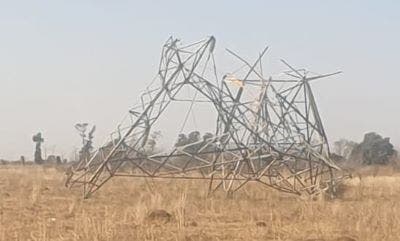Uganda steps up efforts against power infrastructure vandalism

Uganda is revising its electricity law to introduce stringent penalties and mounting an inter-agency operation, to curb an escalating vice of vandalism of energy assets.
Energy and Minerals minister Ruth Nankabirwa told media that the sector had lost USD73 million over the past two years as vandals brought down high voltage transmission lines for their steel and power cables.
Amendments to the power act will introduce steeper penalties for vandalism while the inter-agency effort will bring multiple stakeholders on board, including the steel rolling mills that are the primary customers for the valandalised materials.
“It has also come to our realization that vandalizing electricity assets has a relationship with the unregulated scrap business in the country, and there is therefore need to work with Uganda Manufacturer Association to ensure regulation of the scrap industry,” Nankabirwa said
The assets most attacked include pylons, cables and transmission infrastructure parts made of steel, aluminum wires, copper wires, transformers and transformer oils, poles, underground cables and related accessories. Nankabirwa says in some instances, electricity distribution lines have been cut down without anything getting carries away, which points to possible economic sabotage.
“In the last two years alone, the government has lost over UGX260 billion due to vandalism. Notable cases include the collapse of five towers in Mbalala, Mukono district on the 132kV Owen falls – Lugogo transmission line on 20th September 2018 that led to a national power blackout lasting over three hours. There was further load shedding for a week in some parts of Kampala as the affected towers were being replaced,” the minister revealed.
In another incident, 29 pylons were badly vandalized along the 132kV Tororo – Lira transmission line that is still sunder construction leading to the collapse of thirteen towers, resulting in a slippage of delivery timelines and cost escalation. A single tower for a 132kV transmission line costs as much as USD10,000.
In similar incidents, 156 metric tons of steel equivalent to about 20 towers were vandalized from the 220kV Bujagali – Tororo transmission line leading to collapse of various sections. In some instances, the thick metallic tower parts that are set in concrete to anchor the towers have also been dug out using jack hammers. The 400kV lines evacuating power from the 600MwKaruma HPP to northern Uganda and Kampala in the south, have also suffered heavy vandalism. On the Karuma – Kawanda line alone, 9.5km of aluminum conductor (wire) were cut and stolen together with other tower parts and accessories estimated to be 100 metric tons equivalent to about 7 towers.
National transmission company UETCL reported spending more than UGX 600 million per annum on restori8ng vandalized towers on the existing lines across the country. It is feared that at the current rate of vandalism and the growing length of the transmission lines, these costs will spike if the vice is not contained.
Even medium voltage distribution lines have not been spared with losses estimated at more that USD 7.3 million. The vice is most prevalent in the districts of Mukono, Kayunga, Buikwe, Jinja, Kamuli, Iganga, Mayuge, Bugiri, Busia, Tororo, Mbale, Soroti, Lira, Oyam, Kole, Kyirwandongo, Nakasongola, Luwero, Mpigi, Masaka, Kyotera, Mbarara, Bushenyi, Kiruhura, Kazo, Isingiro, Ntungamo, Kasese and Bulisa.
Kampala and Wakiso districts are believed to provide one of the biggest markets for the stolen electricity infrastructure assets. The vandalized electricity infrastructure assets are believed to be sold to scrap (steel and aluminum) smelters, some service providers within the energy sector who source materials locally, traders of electrical materials and metal welding workshops who use transformer oil in their welding machines.
“The public needs to be aware that interference with the electricity supply network causes power blackouts, threatens the security of our homes, increases the cost of doing business and electricity tariffs, and disrupts vital health and education services as well as our lifestyles. Other effects include; increased project development costs, extended project delivery timelines and overall, affects the economy and national development.,” Nankabirwa said while imploring local leaders to be proactive in protecting national assets.

 African Heads of state head to South Korea next week for Summit talks
African Heads of state head to South Korea next week for Summit talks
 Trading leads as main source of income for Ugandans
Trading leads as main source of income for Ugandans
 New leadership for bankers’ umbrella as total assets top $12 billion
New leadership for bankers’ umbrella as total assets top $12 billion
 Brussels Airlines to announce Nairobi service
Brussels Airlines to announce Nairobi service
 SITA promises enhanced travel experience after Materna acquisition
SITA promises enhanced travel experience after Materna acquisition
 Saudia’s 105 aircraft order stretches A320neo lead over rival Max
Saudia’s 105 aircraft order stretches A320neo lead over rival Max
